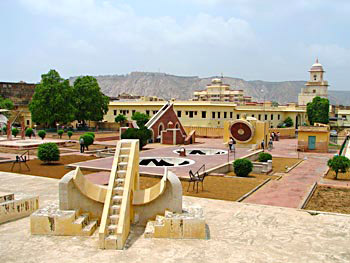Scattered with exuberant 18th and 19th century palaces, Jaipur is the most colourful and beautiful showcase of Rajasthani architecture. The rich historical heritage of Jaipur is reflected in the bounty of its majestic palaces, monuments, museums and buildings. To catch glimpse of these spectacular beauty myriads of zealous tourists and visitors throng the city. Important places of Jaipur are as follows:
Hawa Mahal is one of the important places of Jaipur. It is popularly called the Palace of Winds. In the year 1799 this majestic building was constructed. It is an integral part of the City Palace and was accredited by Sawai Pratap Singh. The Hawa Mahal has been built with a purpose. It was so uniquely built that all the ladies of the royal household could easily view the happenings of the street. In the mean time they remain secluded from public view.
The City Palace juxtaposes architecture of Rajasthani and Mughal. There is a museum, which display weaponry and ammunitions, which had been used by regal family of the ancient times.
 Amongst important places of Jaipur one identifies Jantar Mantar. For showing his passion for astronomy, Jai Singh built this Jantar Mahal. It is situated near City Palace. It is one of the 5 observatories constructed by him. Amongst the other observatories Jantar Mantar is most prominent and best conserved one. With the help if instrument, various astronomical calculations like site of stars etc can be done.
Amongst important places of Jaipur one identifies Jantar Mantar. For showing his passion for astronomy, Jai Singh built this Jantar Mahal. It is situated near City Palace. It is one of the 5 observatories constructed by him. Amongst the other observatories Jantar Mantar is most prominent and best conserved one. With the help if instrument, various astronomical calculations like site of stars etc can be done.
Central Museum is another special attraction of Jaipur. It has a huge collection of artifacts like dresses, carpentry, brassware, ornaments and clayware. It has its location in the Ram Niwas Gardens.
Not only that several fortresses thatare built in the top of the hills also is treasure of Jaipur city. Nahargarh, Jaigarh, and Amber forts are significant thereby recreating the glory of the ancient times in its vivacity. Each one of them is an epitome of imperial trends of magnificence and martial practice.
There are several other important places of interests for enchanting the tourists. Albert Museum, Jaipur Museum, Sisodia Rani Park, Lakshmi Narain Temple, Kanak Vrindavan, The Rajmahal Palace, Birla Mandir Planetarium, Rambagh Palace (now a Luxury hotel), and other parks deserve special mentioning.
In the vicinity also one finds no dearth of important places like Ramgarh, Abhaneri, Balaji, and Karauli.



















